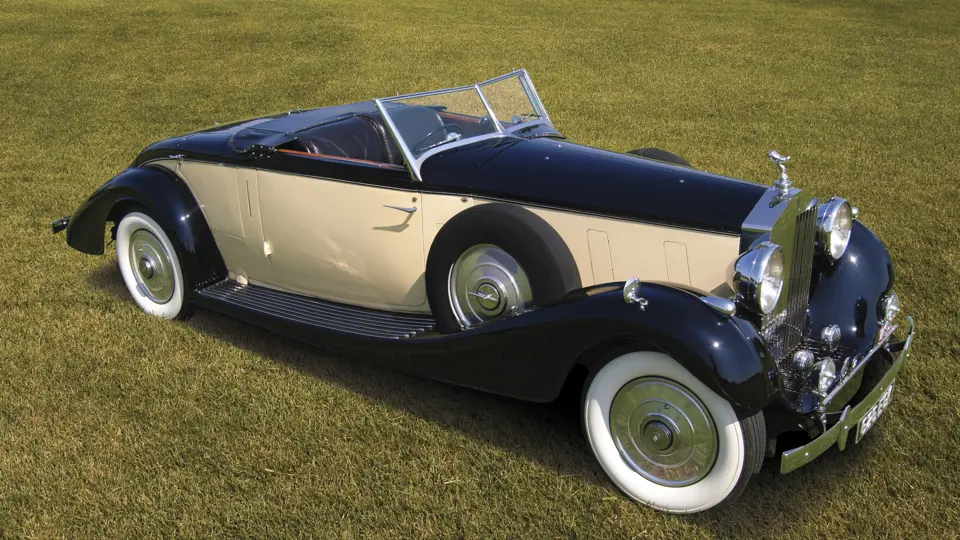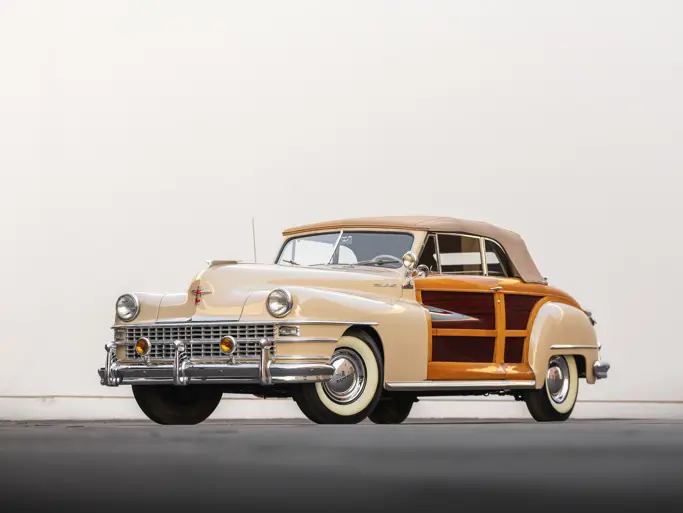The only Phantom III Henley Roadster ever built with remarkable provenance
Coachwork by Brewster/Inskip
Chassis no. 3CP18
Engine no. S98J
40/50 hp, 7,338 cc overhead valve V12 60 engine, four-speed manual transmission, unequal length wishbone, oil immersed, coil spring front suspension, semi-elliptic rear suspension, four-wheel servo assisted drum brakes. Wheelbase: 142"
Frederick Henry Royce strove for perfection in everything that he did and this was epitomised in a comment he made to his local vicar in West Wittering where he lived. He had just finished stripping and rebuilding the vicar’s lawnmower and made a comment which inspired the famous sculptor Eric Gill, the vicar’s son, to carve the Latin words in a stone mantelpiece in Royce’s house: Quidvis recte factum: quamvis humile praeclarum. It was the maxim that Royce lived his life by. “Whatever is rightly done, however humble, is noble.”
Henry Royce’s first motor powered vehicle was a De Dion Quadricycle. He followed this with a second-hand, 10 hp two-cylinder French Decauville. The standard of workmanship was not good so Royce decided to build a car of his own. The first Royce car was constructed in a corner of his Cooke Street works in Manchester. On April 1, 1904, he left the factory to the cheers of the workforce for the first test run. He was so pleased that he kept on going back to his house at Knutsford, fifteen miles away, arriving without mishap - a remarkable feat in those days.
Royce went on to make two more of these cars; each had many improvements, but was basically to the same design. His partner, Ernest Claremont, had the second car and friend, and fellow Director, Henry Edmunds, the third. Edmunds was a motoring enthusiast and pioneer in the electrical industry, and later became known as the Godfather of Rolls-Royce. He boasted of his wonderful car to another friend, Claude Johnson, who had now joined C.S. Rolls and Co., the car dealers and importers, in Fulham, London. Johnson passed on the news to Rolls that a company on Cooke Street in Manchester was producing a superb little twin-cylinder car that might be the best built in England. Charles was reluctant to travel all the way to Manchester, as he had heard such claims before. Royce was equally unwilling to take time off from his work to visit a salesman in London. But the die was now cast for Royce and Rolls to meet.
In the end, Rolls went to Manchester and within minutes of seeing the little 10hp Royce car, knew he had found gold. The dining room of the Midland Hotel, Manchester, was the setting for the two men to take stock of each other. The meeting went well considering their totally dissimilar backgrounds and the two men hit it off immediately. A drive in the Royce car showed Henry that Charles was well and truly impressed. So much so that Rolls agreed to sell all the cars that Royce could build and came away from the meeting saying, “I have met the greatest engineer in the world.” It was also agreed that the cars would be known as Rolls-Royce motor cars. The famous radiator shape was devised and shortly afterwards the badge of entwined first letters from each man’s surname. Royce realised that in Rolls he had a man who not only understood motor cars but had the skills of a consummate salesman. He also realised that The Honourable Charles would have a foot in the door of the aristocracy that would not be possible for the son of a Midlands master miller such as himself.
On the train journey to Manchester for the meeting, Rolls told Edmunds that he wanted to produce a car connected with his name that would become as much a household word as Broadwood was among pianofortes, or Chubb among safes. It was a prophetic conversation and little did the two men know that over a hundred years later the name Rolls-Royce would still be a household name across the world and remain a symbol synonymous with the very best.
As long ago as 1906 the Rolls-Royce 40/50 hp, later to become known as the Silver Ghost, was being described as “The Best Car in the World.”
Like every Rolls-Royce model, the Silver Ghost was subject to continuing modification and detail improvements and continued with worldwide success until 1925.
At the same time that the Silver Ghost model was sweeping all before it, Rolls was becoming more and more interested in the new discipline of flying and less interested in motoring. He was the first person to fly the English Channel in both directions and tragically the first Englishman to die in a flying accident. His untimely death at the age of 32 took place at the Bournemouth Air Show on July 12, 1910. Although Charles Rolls was only involved with Rolls-Royce for six short years, he had brought with him his reputation as one of the best-known and popular figures of the day. As well as this, his knowledge, intellect and tremendous drive and enthusiasm played a major part in how Rolls-Royce began and the direction in which it would go. Royce was distraught at his friend’s death and wept openly.
After The First World War, in 1922 a smaller 20 hp Rolls-Royce model was introduced. It cost forty percent less than the Silver Ghost while meeting the same exacting standards of design, materials and workmanship. An American factory had been opened in Springfield, Massachusetts in 1921 and a total of 2,944 40/50 hp cars were built in the US. The factory closed in 1931, a victim of the Depression that followed the Wall Street Crash.
Phantom II and III
The New Phantom was launched in 1925 and was retrospectively called the Phantom I when the Phantom II was produced in 1929 in response to increasing competition from other manufacturers. 1929 also saw Britain win the Schneider Trophy with Rolls-Royce powered Supermarine aircraft. This feat, which was equalled in 1931, prompted the awarding of a Baronetcy to Royce in 1931 but by then Royce was a very sick man. He died on April 22, 1933 at age seventy. Having started work designing the Phantom III in 1932, Royce ensured his engineering team followed his own principles of excellence. Prompted by competition from America, Royce knew that Cadillac would soon introduce a V16 and just about every other US manufacturer was using a V12 in their top models. In addition Hispano-Suiza had announced the 68, with a light-alloy V12. By then Rolls-Royce was very experienced with light-alloy construction and its V12 aero-engines had been a tremendous success. Sir Frederick Henry Royce’s last car design, the V12 engined Phantom III, was a masterpiece, but it was left to his successors to make the car a reality in 1936.
Code-named Spectre, the Phantom III was unveiled at the 1935 Olympia Motor Show and was acclaimed as the most technically advanced car in production anywhere in the world. The V12 overhead valve engine had a one-piece aluminium alloy crankcase and cylinder blocks, aluminium head and cast-iron, wet cylinder liners. The chassis was of cruciform-braced, box-girder design with wishbone front suspension and semi-elliptic rear springs. The four-speed gearbox had synchromesh on the highest three gears. It broke new ground as the first British car with hydraulic, self-adjusting tappets and hydraulic shock absorbers controlled from the driving seat. No effort had been spared to make it the ultimate in refinement. In a road test, Autocar magazine described in awe the silence of the V12 engine, the flexibility of the gearbox. “…certainly also it has a wider range of performance of the kind that counts in modern road conditions, its acceleration being, to say the least, thrilling.” Autocar went on to say, “Somewhere is an ultimate in the highest expression of road travel comfort and performance and the Phantom III is beyond question the nearest approach to it as yet.”
John S. Inskip worked as a salesman for Locomobile’s New York distributor before moving to Rolls-Royce’s showroom on Eighth Avenue and 58th Street and by 1930, when coachbuilder Brewster’s Fifth Avenue showroom was closed, Inskip was running the Eighth Avenue operation. Robert W. Schuette’s small distributorship was also taken over by Rolls-Royce of America at this time. By 1934 Inskip was the President of the Springfield Manufacturing Corporation which was effectively a reorganized Brewster and Co. Inskip later acquired the New York distributorship for Rolls-Royce and leased Brewster’s former Long Island City factory where he would continue to build bodies. As well as having a showroom on 57th and Fifth in Manhattan, his business expanded to include dealerships in West Palm Beach, Florida and Providence, Road Island.
Seven hundred and twenty-seven Rolls-Royce Phantom IIIs were made between 1936 and 1939. Chassis 3CP18, the car presented here, was the only Henley Roadster built and was delivered to Colonel Joseph Samuels of Providence, Road Island on June 19, 1937. Samuels was a wealthy philanthropist with business interests in retail and broadcasting. The Outlet Company was based in Rhode Island, with its flagship store in Providence. His broadcasting companies included WJAR radio and television, also based in the same city.
Doctor Alexander Hamilton Rice bought the car in August of 1940 and would own it for the next thirteen years. Rice was a surgeon and explorer who made trips into the South American jungles and up the Amazon. His wife Eleanor accompanied him on his explorations and was reported to have gone further into the jungles than any other woman. On one trip they were attacked by cannibals and shot several of them before abandoning the journey. A New York and Newport society woman noted for her philanthropy Eleanor Widener married Dr. A.H. Rice in 1915, three years after her first husband, George D. Widener and oldest son, Harry Elkins Widener, perished on the Titanic. Her first marriage had united two of Philadelphia’s wealthiest families and she was regarded as one of the city’s most beautiful women. Eleanor Rice survived the sinking of the Titanic and manned the oars in one of the lifeboats. She died in 1937.
3CP18 features in both ‘Those Elegant Rolls-Royce’ by Dalton and ‘Rolls-Royce in America’ by De Campi. The car won a CCCA national first prize over fifty years ago. This Phantom III has won numerous other awards and still has its early CCCA senior numbers. 3CP18 was owned for most of its life by noted collector Andrew Darling and has since been part of another major collection. It is described as being very original, with a repaint in the 1950s. The total mileage is less than 40,000.
The very first road test of the Phantom III in Motor in 1936 described the car as, “Docile, yet very fast and powerful; big, yet easy to manage; supremely comfortable but with exceptional road-holding qualities; these are my outstanding impressions of the 40/50 hp Rolls-Royce Phantom III saloon.” 3CP18 is unique and as the only Henley Roadster built, this Inskip bodied car is quite possibly the most elegant and sporting Phantom III ever made and would once again grace any collection or, indeed, important events across the world.



 | Monterey, California
| Monterey, California


